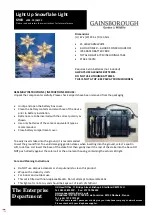
31
ITALIANO
ENGLISH
Alcune funzioni della macchina possono avere la predisposizione per la connessione agli
attacchi rapidi del mezzo (vedere: Descrizione e impiego comandi) per completare l’in-
stallazione collegare ogni tubo provvisto di attacco rapido ad uno disponibile predisposto
sul mezzo.
3.8 VERIFICA CAPACITÀ DI SOLLEVAMENTO E STABILITÀ DELLA
TRATTRICE ABBINATA ALLA MACCHINA
L’applicazione di una macchina al trattore, comporta una diversa distribuzione dei pesi
sugli assi (Fig. 21).
È consigliabile pertanto aggiungere apposite zavorre nella parte anteriore del trattore in
modo da ripartire adeguatamente il peso sugli assi.
La zavorra da applicare si calcola con la seguente formula:
S = S1 + S2
Qualora l’attrezzatura venga montata su trattici agricole omologate ed immatricolate pri-
ma del 6 Maggio 1997, occorre verificare anche il rispetto della seguente relazione:
M < 0.3 x T
I
= interasse ruota trattrice (cm).
d
= distanza dell’asse anteriore dalle zavorre (cm).
T
= massa della tra operatore (75 kg).
Z
= massa della zavorra.
M
= massa della macchina operatrice (kg).
S
= sbalzo dall’asse posteriore della macchina operatrice (cm).
S1
= distanza dall’asse posteriore all’attacco parallele (cm).
S2
= distanza tra foro attacchi barre e baricentro macchina operatrice (cm).
3.9 OPERAZIONI PRELIMINARI
PERICOLO
Assicurarsi prima di ogni operazione che il motore del mezzo sia fermo, il freno di
stazionamento inserito e la chiave di avviamento tolta dal quadro.
Prima di avviare la decespugliatrice è necessario:
- Verificare le condizioni della stessa in particolar modo se viene usata da più persone.
- Assicurarsi che tutti i comandi siano in posizione neutra compresi quelli del cambio
mezzo.
Some of the machine’s functions may be pre-engineered for connection to the vehicle’s
quick couplings (see: Description and use of the controls). To complete the installation,
connect each pipe with a quick coupling to an available one on the vehicle.
3.8 CHECK THE LIFTING CAPACITY AND STABILITY OF THE
TRACTOR TO WHICH THE MACHINE IS HITCHED
Assembly of a implement on the tractor will shift the weights on the axles (Fig.21).
It is there fore advisable to add weights to the front part of the tractor in order to balance
the weights on the axles themselves.
The ballast required is calculated by means of the following formula:
S = S1 + S2
If the implement is hitched to approved agricultural tractors registered before 6th May
1997, also check to make sure that the following relation has been complied with:
M < 0.3 x T
I
= tractor wheelbase (cm).
d
= distance of front axle from ballast (cm).
T
= weight of t operator (75 kg).
Z
= weight of ballast (kg).
M
= weight of implement (kg).
S
= overhang from rear axle of the machine (cm).
S1
= distance of rear axle from parallel hitch (cm).
S2
= distance between bar hitch hole and center of gravity of machine (cm).
3.9 PRELIMINARY OPERATIONS
DANGER
Before proceeding with any operation, make sure that the vehicle’s engine is off,
the parking brake applied and that the ignition key has been removed from the
dashboard.
Before starting the land clearing machine:
- Check its conditions, particularly if it is used by several different persons.
- Make sure that all the controls are in the neutral position, including those of the vehicles
gearshift.
Z > M x S - 0.2 x T x i
d + i
Z > M x S - 0.2 x T x i
d + i
















































